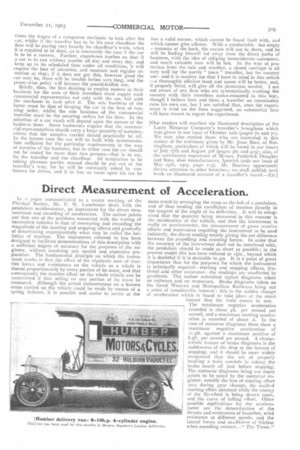Direct Measurement of Acceleration.
Page 11

If you've noticed an error in this article please click here to report it so we can fix it.
In a paper communicated to a recent meeting of the Physical Society, Mr. F. W. Lanchester deals with the pendulum accelerometer, an instrument for the direct measurement and recording of acceleration. The author points out that one of the problems connected with the testing of locomotive vehicles is that of measuring and recording the magnitude of the starting and stopping effects and generally of determining experimentally what may be called the ballistics of traction. The instrument referred to has been designed to facilitate determinations of this description with a sufficient degree of accuracy for the purposes of she engineer, without involving any special and expensive preparation. The fundamental principle on which the instrument works is that the effect of the algebraic sum of tractive forces and resistances on the vehicle as a whole is shared proportionately by every portion of its mass, and that consequently the tractive effort on the whole vehicle can be ascertained if that acting on any portion of its mass be measured. Although the actual measurement on a known mass carried on the vehicle could be made by means of a spring balance, it is possible and easier to arrive at the
same result by arranging the mass as the bob of a pendulum, and of thus reading the co-efficient of, traction directly in the tangent of the angle of its deflection. It will be recognised that the quantity being measured in this manner is the acceleration of the vehicle, and that the instrument is really an accelerometer, the measurement of gross tractive efforts and resistances requiring the instrument to be used indirectly, the direct reading merely giving the net difference between the propelling and resisting forces. In order that the accuracy of the instrument shall not be interfered with, the pendulum should be made as short as possible; in the present model this has been reduced to iin., beyond which it is doubtful if it is desirable to go. It is a point of great importance that for the purposes for which the instrument is principally required—starting and stopping effects, frictional and other resistance--the readings are unaffected by gradients. The author submitted typical diagrams taken on railways and on motorcars. Brake diagrams taken on the Great Western and Metropolitan Railways bring out a point of considerable interest : this is the sudden change of acceleration which is found to take place at the exact instant that the train conies to rest.
The maximum negative acceleration
recorded is about 4ft. per second per second, and a maximum starting acceleration is recorded of about .6. In the case of motorcar diagrams these show a maximum negative acceleration of r.5ft. against a maximum positive of 8.5ft. per second per second. A characteristic feature of brake diagrams is the suddenness of the drop at the instant of stopping, and it should be more widely recognised that the art of properly braking a train consists in taking the brake nearly off just before stopping. The motorcar diagrams bring out many points to be noted by the motorcar engineer, notably the loss of starting effort area during gear change, the exalted starting effort obtained while the energy of the fly-wheel is being drawn upon, and the curve of falling effort. Other possible applications for the accelerometer are the determination of the thrusts and resistances of launches, wind resistance at different speeds, and the lateral forces and co-efficient of friction when rounding corners.--" The Times."


















